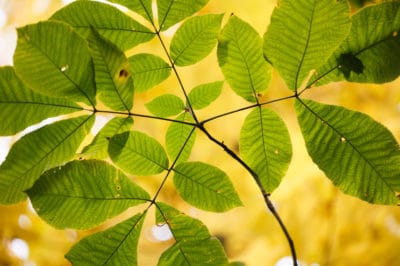Spring
In late winter, shagbark hickories push out tan, teardrop-shaped leaf buds covered in purplish scales. As temperatures warm, the buds begin swelling with sugary sap. The scales peel back like petals, and the new leaves unfurl with five to seven leaflets connected to a central stem, or rachis. Each newly opened leaflet has:
- A yellowish-green upper surface.
- A paler green, lightly haired lower surface.
- Shallow-toothed edges with two or three tufts of tiny hairs per tooth. They’re the clearest clue to the tree’s identity, because only shagbark hickory leaflets have them.
Summer
As a shagbark hickory leaf matures, its leaflets’ upper surfaces become shiny and medium to deep green. Its lower ones remains dull and pale green while shedding most of its hairs except for thin, short ones along the veins.
Photosynthesis
The leaf’s green chlorophyll pigment traps sunlight, then combines it with water and carbon dioxide in sugars that fuel the tree. The tree’s roots and vascular system deliver nutrients and water to the leaf so it can continue functioning. The exchanges continue until shortening daylight hours signal them to stop.
Fun Fact
In mid- to late summer, shagbark hickory leaves often host one of North America’s largest caterpillars, the ferocious-looking (but entirely harmless) blue-green hickory horned devil. It grows up to 5.5 inches long, with four curved, black-tipped orange spines protruding from behind its head.
Fall
Once a shagbark hickory’s nuts have matured and fallen, its task of ensuring the next generation is completed for the year. Sometime in fall, depending on where in USDA zones 4 through 8 it grows, the tree begin preparing for dormancy.
The Abscission Zone
The area where the leaf’s stem, or petiole, connects to its twig is the abscission zone. It contains specialized connective tissue designed to break apart easily. In fall, the tree seals off the connection between the petiole and twig. The abscission zone breaks apart, severing the pipeline that carried water and nutrients to the leaf and sugars from the leaf to the tree.
Leaf Death
Deprived of water and food, the leaf begins to die. Its chlorophyll fades, revealing the golden-yellow pigment beneath. Eventually, its surfaces and stem become brown and brittle and it drops from the tree.
